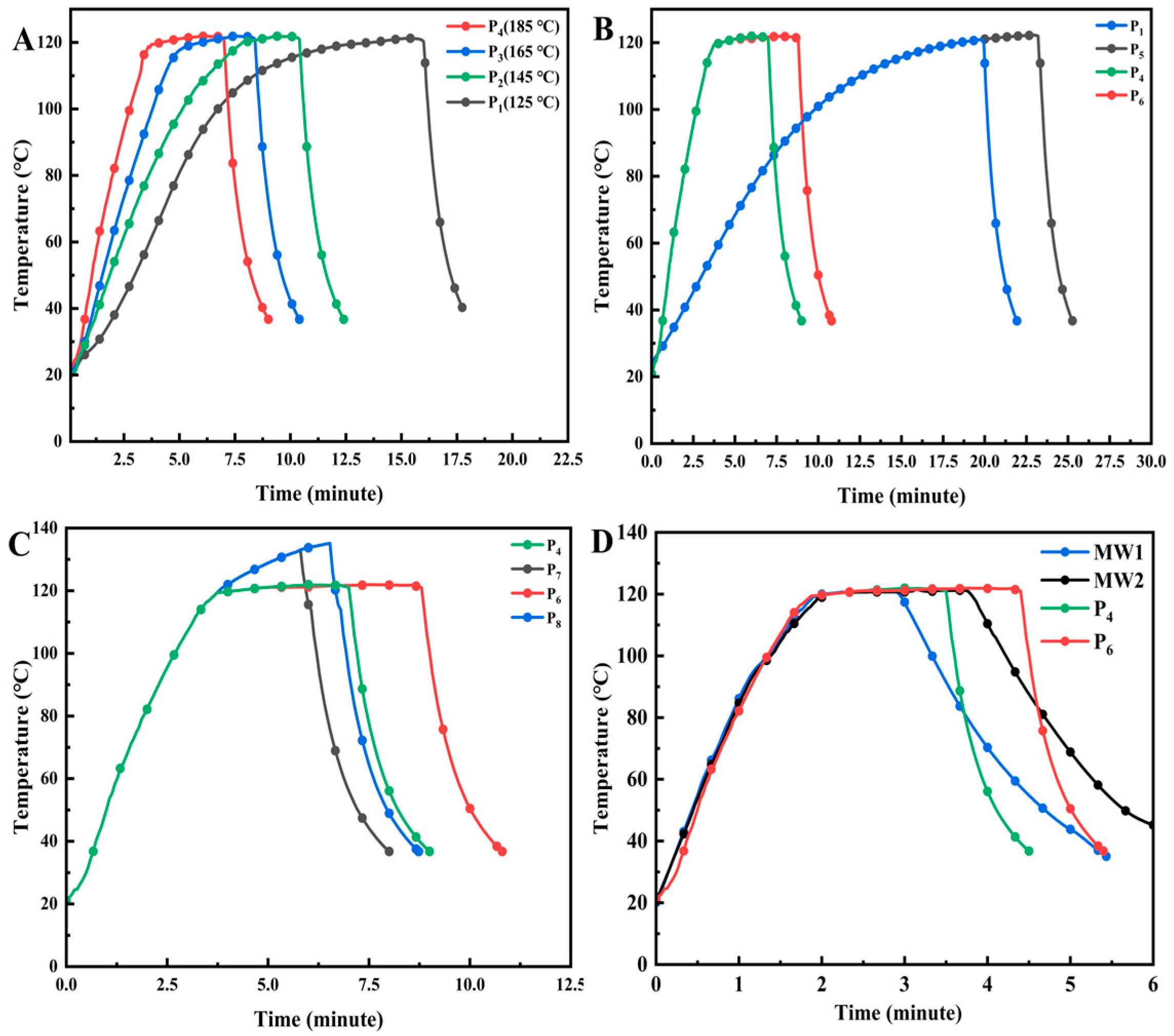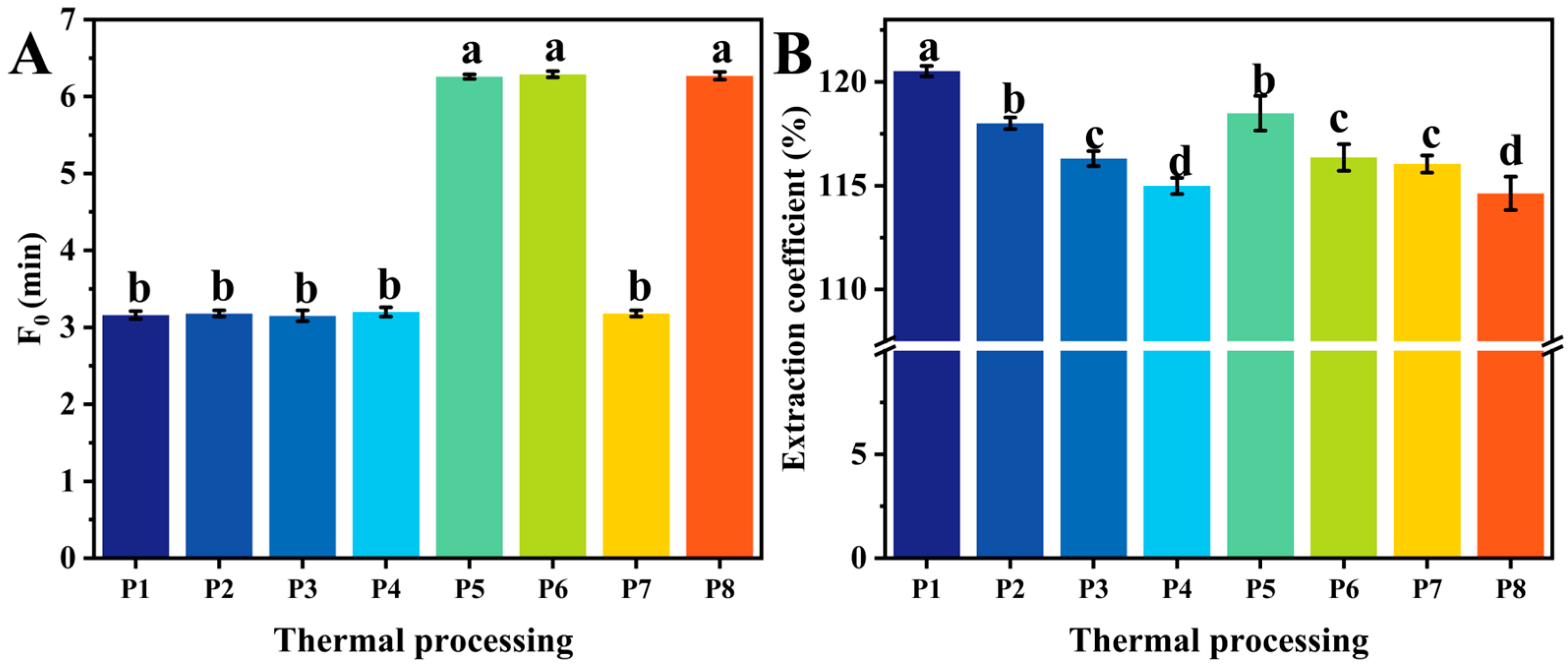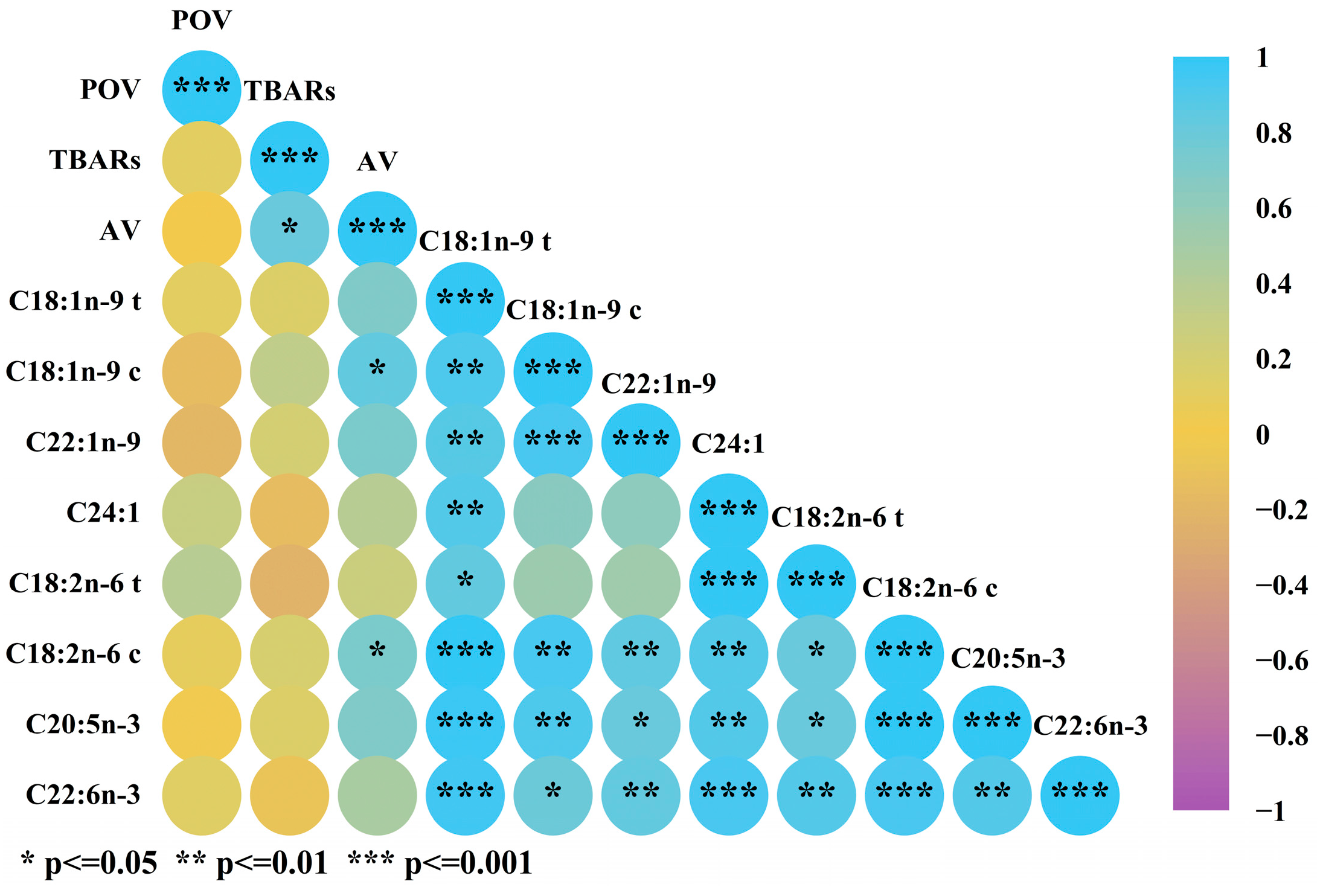Microwave Heating Characteristics on Lipid Quality in Sterilized Rainbow Trout (Oncorhynchus mykiss) Using Designed Heating Processing
Abstract
:1. Introduction
2. Materials and Methods
2.1. Sample Preparation
2.2. Traditional Thermal Processing System
2.2.1. Different Oil Temperatures
2.2.2. Different Maximum Temperatures
2.2.3. Different Thermal Processing Levels
2.3. Microwave-Assisted Thermal Sterilization
2.4. Dielectric Properties of Rainbow Trout at 915 MHz
2.5. Lipid Extraction
2.6. Determination of Lipid Oxidation
2.7. Methylation of Fatty Acids
2.8. Analysis of Fatty Acids
2.9. Statistical Analysis
3. Results and Discussion
3.1. Dielectric Properties of Rainbow Trout at 915 MHz
3.2. Time–Temperature Profile and F0
3.3. Extraction Coefficients of Total Lipids
3.4. Lipid Oxidation
3.5. Extraction Coefficients of Fatty Acids
3.5.1. Different Oil Temperatures
3.5.2. Different Thermal Processing Levels at a Low Heating Rate
3.5.3. Differences in Thermal Processing Levels at High Heating Rates
3.5.4. Different Maximum Temperatures
3.6. Correlation Analysis of Fatty Acid Extraction Coefficients and Oxidation Values
3.7. Microwave Thermal Processing
4. Conclusions
Author Contributions
Funding
Data Availability Statement
Conflicts of Interest
References
- Jin, Y.Q.; Tang, J.M.; Sablani, S.S. Food component influence on water activity of low-moisture powders at elevated temperatures in connection with pathogen control. Lwt-Food Sci. Technol. 2019, 112, 108257. [Google Scholar] [CrossRef]
- Wang, X.; Yi, Y.; Guo, C.; Wang, X.; Yu, J.; Xia, S. Enhanced sodium release and saltiness perception of surimi gels by microwave combined with water bath heating. Food Hydrocoll. 2023, 134, 108018. [Google Scholar] [CrossRef]
- Tang, J. Unlocking Potentials of Microwaves for Food Safety and Quality. J. Food Sci. 2015, 80, E1776–E1793. [Google Scholar] [CrossRef] [PubMed]
- Chandrasekaran, S.; Ramanathan, S.; Basak, T. Microwave food processing—A review. Food Res. Int. 2013, 52, 243–261. [Google Scholar] [CrossRef]
- Benlloch-Tinoco, M.; Pina-Pérez, M.C.; Martínez-Navarrete, N.; Rodrigo, D. inactivation kinetics under microwave and conventional thermal processing in a kiwifruit puree. Innov. Food Sci. Emerg. 2014, 22, 131–136. [Google Scholar] [CrossRef]
- Luan, D.; Li, S.; Wang, Y.; Wang, Y. Studying the non-thermal effects of microwave on amino acids in sterilized rainbow trout (Oncorhynchus mykiss) fillets using a double side approximating method. Food Res. Int. 2023, 173, 113352. [Google Scholar] [CrossRef]
- Marszalek, K.; Mitek, M.; Skapska, S. Effect of Continuous Flow Microwave and Conventional Heating on the Bioactive Compounds, Colour, Enzymes Activity, Microbial and Sensory Quality of Strawberry Puree. Food Bioprocess Technol. 2015, 8, 1864–1876. [Google Scholar] [CrossRef]
- Wang, Y.; Tang, J.; Rasco, B.; Wang, S.J.; Alshami, A.A.; Kong, F.B. Using whey protein gel as a model food to study dielectric heating properties of salmon (Oncorhynchus gorbuscha) fillets. Lwt-Food Sci. Technol. 2009, 42, 1174–1178. [Google Scholar] [CrossRef]
- Ma, R.; Liu, X.; Meng, Y.; Wu, J.; Zhang, L.; Han, B.; Qian, K.; Luo, Z.; Wei, Y.; Li, C. Protein nutrition on sub-adult triploid rainbow trout (1): Dietary requirement and effect on anti-oxidative capacity, protein digestion and absorption. Aquaculture 2019, 507, 428–434. [Google Scholar] [CrossRef]
- Rajkowska-Mysliwiec, M.; Pokorska-Niewiada, K.; Witczak, A.; Balcerzak, M.; Ciecholewska-Jusko, D. Health benefits and risks associated with element uptake from grilled fish and fish products. J. Sci. Food Agric. 2022, 102, 957–964. [Google Scholar] [CrossRef]
- Li, R.; Sun, Z.; Zhao, Y.; Li, L.; Yang, X.; Cen, J.; Chen, S.; Li, C.; Wang, Y. Application of UHPLC-Q-TOF-MS/MS metabolomics approach to investigate the taste and nutrition changes in tilapia fillets treated with different thermal processing methods. Food Chem. 2021, 356, 129737. [Google Scholar] [CrossRef] [PubMed]
- Gómez-Limia, L.; Cobas, N.; Franco, I.; Martínez-Suárez, S. Fatty acid profiles and lipid quality indices in canned European eels: Effects of processing steps, filling medium and storage. Food Res. Int. 2020, 136, 109601. [Google Scholar] [CrossRef]
- Mohan, C.; Remya, S.; Murthy, L.; Ravishankar, C.; Kumar, K. Effect of filling medium on cooking time and quality of canned yellowfin tuna (Thunnus albacares). Food Control 2015, 50, 320–327. [Google Scholar] [CrossRef]
- Naseri, M.; Rezaei, M.; Moieni, S.; Hosseini, H.; Eskandari, S. Effects of different filling media on the oxidation and lipid quality of canned silver carp (Hypophthalmichthys molitrix). Int. J. Food Sci. Technol. 2011, 46, 1149–1156. [Google Scholar] [CrossRef]
- Gezahegn, Y.; Tang, J.M.; Pedrow, P.; Sablani, S.S.; Tang, Z.W.; Barbosa-Cánovas, G. Development and validation of engineering charts: Heating time and optimal salt content prediction for microwave assisted thermal sterilization. J. Food Eng. 2024, 369, 111909. [Google Scholar] [CrossRef]
- Tang, J.; Hong, Y.; Inanoglu, S.; Liu, F. Microwave pasteurization for ready-to-eat meals. Curr. Opin. Food Sci. 2018, 23, 133–141. [Google Scholar] [CrossRef]
- Gezahegn, Y.A.; Tang, J.M.; Sablani, S.S.; Pedrow, P.D.; Hong, Y.K.; Lin, H.M.; Tang, Z.W. Dielectric properties of water relevant to microwave assisted thermal pasteurization and sterilization of packaged foods. Innov. Food Sci. Emerg. 2021, 74, 102837. [Google Scholar] [CrossRef]
- Bligh, E.; Dyer, W. A rapid method of total lipid extraction and purification. Can. J. Biochem. Physiol. 1959, 37, 911–917. [Google Scholar] [CrossRef]
- Wang, S.; Zhang, J.; Wang, Y.; Zhu, Q.; Wang, X.; Luan, D. Effects of Microwave Pasteurization on the Quality and Shelf-Life of Low-Sodium and Intermediate-Moisture Pacific Saury (Cololabis saira). Foods 2023, 12, 2000. [Google Scholar] [CrossRef] [PubMed]
- Jiang, J.W.; Wang, H.L.; Guo, X.Q.; Wang, X.C. Effect of radio frequency tempering on the color of frozen tilapia fillets. Lwt-Food Sci. Technol. 2021, 142, 110897. [Google Scholar] [CrossRef]
- Glowacz-Rózynska, A.; Tynek, M.; Malinowska-Panczyk, E.; Martysiak-Zurowska, D.; Pawlowicz, R.; Kolodziejska, I. Comparison of oil yield and quality obtained by different extraction procedures from salmon (Salmo salar) processing byproducts. Eur. J. Lipid Sci. Technol. 2016, 118, 1759–1767. [Google Scholar] [CrossRef]
- ISO 12966-2:2017; Animal and Vegetable Fats and Oils—Gas Chromatography of Fatty Acid Methyl Esters Part 2: Preparation of Methyl Esters of Fatty Acids. ISO: Geneva, Switzerland, 2017.
- Ding, K.; Wang, Y.; Luan, D. Effects of high-temperature short-time processing on nutrition quality of Pacific saury (Cololabis saira) using extracted fatty acids as the indicator. Food Sci. Nutr. 2023, 11, 157–167. [Google Scholar] [CrossRef] [PubMed]
- Hu, L.; Wang, Y.; Guo, C.; Lai, K.; Luan, D. Exploring the microwave non-thermal effects on the fatty acid composition of Atlantic salmon (Salmo salar) during pasteurization using the same time–temperature profiles method. J. Food Process. Preserv. 2021, 45, 15950. [Google Scholar] [CrossRef]
- Ergün, A.; Çaglar, D.; Baysal, T. Inactivation of Zygosaccharomyces rouxii in organic intermediate moisture apricot and fig by microwave pasteurization. Lwt-Food Sci. Technol. 2021, 152, 112294. [Google Scholar] [CrossRef]
- Hennebelle, M.; Villeneuve, P.; Durand, E.; Lecomte, J.; van Duynhoven, J.; Meynier, A.; Yesiltas, B.; Jacobsen, C.; Berton-Carabin, C. Lipid oxidation in emulsions: New insights from the past two decades. Prog. Lipid Res. 2024, 94, 101275. [Google Scholar] [CrossRef]
- Zhou, Y.; Zhang, Y.; Dong, X. Determination of heterocyclic amines in braised sauce beef and the effects of different cooking conditions on the formation of heterocyclic amines. J. Sci. Food Agric. 2022, 102, 617–627. [Google Scholar] [CrossRef]
- del Pulgar, J.; Gázquez, A.; Ruiz-Carrascal, J. Physico-chemical, textural and structural characteristics of sous-vide cooked pork cheeks as affected by vacuum, cooking temperature, and cooking time. Meat Sci. 2012, 90, 828–835. [Google Scholar] [CrossRef]
- Liu, W.; Luo, X.; Huang, Y.; Zhao, M.; Liu, T.; Wang, J.; Feng, F. Influence of cooking techniques on food quality, digestibility, and health risks regarding lipid oxidation. Food Res. Int. 2023, 167, 112685. [Google Scholar] [CrossRef]
- Zhou, X.; Pedrow, P.; Tang, Z.; Bohnet, S.; Sablani, S.; Tang, J. Heating performance of microwave ovens powered by magnetron and solid-state generators. Innov. Food Sci. Emerg. 2023, 83, 103240. [Google Scholar] [CrossRef]
- Yu, X.; Li, L.; Xue, J.; Wang, J.; Song, G.; Zhang, Y.; Shen, Q. Effect of air-frying conditions on the quality attributes and lipidomic characteristics of surimi during processing. Innov. Food Sci. Emerg. 2020, 60, 102305. [Google Scholar] [CrossRef]
- Moreno, M.; Olivares, D.; López, F.; Adelantado, J.; Reig, F. Determination of unsaturation grade and trans isomers generated during thermal oxidation of edible oils and fats by FTIR. J. Mol. Struct. 1999, 482, 551–556. [Google Scholar] [CrossRef]
- Garcia, M.; Paula, V.; Olloqui, N.; Garcia, D.; Combarros-Fuertes, P.; Estevinho, L.; Arias, L.; Banuelos, E.; Baro, J. Effect of different cooking methods on the total phenolic content, antioxidant activity and sensory properties of wild Boletus edulis mushroom. Int. J. Gastron. Food Sci. 2021, 26, 100416. [Google Scholar] [CrossRef]
- Lian, F.; Cheng, J.; Sun, D. Insight into the effect of microwave treatment on fat loss, fatty acid composition and microstructure of pork subcutaneous back fat. Lwt-Food Sci. Technol. 2023, 187, 115297. [Google Scholar] [CrossRef]
- Zhang, L.; Zhang, M.; Yang, X.; Chen, L.; Cheng, W.; Liang, P. Changes in Lipid Content with Roasting Temperature of Large Yellow Croaker (LARIMICHTHYS CROCEA) Roe. Ital. J. Food Sci. 2020, 32, 970–982. [Google Scholar] [CrossRef]
- Foerster, I.; Seames, W.; Oleksik, J.; Kubatova, A.; Ross, A. A Comprehensive Study of Techniques to Optimize the Extraction of Lipids from the Autotrophic Strain of the Microalgae Chlorella vulgaris. Life 2023, 13, 1997. [Google Scholar] [CrossRef] [PubMed]
- Zghaibi, N.; Omar, R.; Kamal, S.M.M.; Biak, D.R.A.; Harun, R. Kinetics Study of Microwave-Assisted Brine Extraction of Lipid from the Microalgae Nannochloropsis Nannochloropsis sp. Molecules 2020, 25, 784. [Google Scholar] [CrossRef] [PubMed]
- Feng, W.L.; Xiong, H.; Wang, W.G.; Duan, X.L.; Yang, T.; Wu, C.; Yang, F.; Xiong, J.; Wang, T.L.; Wang, C.W. Energy consumption analysis of lipid extraction from black soldier fly biomass. Energy 2019, 185, 1076–1085. [Google Scholar] [CrossRef]
- Wang, K.; Zhu, G.; Li, Y.; Chen, S.; Rashid, A.; Wang, X.; Wu, X. Non-thermal effects of microwave irradiation alleviates postharvest chilling injury of peach fruit by retarding phenolic accumulation and enhancing membrane stability. Food Chem. 2023, 411, 135448. [Google Scholar] [CrossRef]
- Cao, H.; Wang, X.; Liu, J.; Sun, Z.; Yu, Z.; Battino, M.; El-Seedi, H.; Guan, X. Mechanistic insights into the changes of enzyme activity in food processing under microwave irradiation. Compr. Rev. Food Sci. Food Saf. 2023, 22, 2465–2487. [Google Scholar] [CrossRef]
- Cavalcante, T.; Funcia, E.; Gut, J. Inactivation of polyphenol oxidase by microwave and conventional heating: Investigation of thermal and non-thermal effects of focused microwaves. Food Chem. 2021, 340, 127911. [Google Scholar] [CrossRef]







| Processing Parameter | No | Oil Bath Temperature (°C) | Target Water Temperature (°C) | Target F0 (min) |
|---|---|---|---|---|
| Different heating rates | P1 | 128 | 122 | 3.0 |
| P2 | 148 | 122 | 3.0 | |
| P3 | 168 | 122 | 3.0 | |
| P4 | 188 | 122 | 3.0 | |
| Different thermal processing levels | P1 | 128 | 122 | 3.0 |
| P5 | 128 | 122 | 6.0 | |
| P4 | 188 | 122 | 3.0 | |
| P6 | 188 | 122 | 6.0 | |
| Different maximum water temperatures | P4 | 188 | 122 | 3.0 |
| P7 | 188 | 132 | 3.0 | |
| P6 | 188 | 122 | 6.0 | |
| P8 | 188 | 132 | 6.0 | |
| Microwave | MW1 | 2.50 min irradiation | No holding time | |
| MW2 | 2.50 min irradiation | 1.00 min holding time |
Disclaimer/Publisher’s Note: The statements, opinions and data contained in all publications are solely those of the individual author(s) and contributor(s) and not of MDPI and/or the editor(s). MDPI and/or the editor(s) disclaim responsibility for any injury to people or property resulting from any ideas, methods, instructions or products referred to in the content. |
© 2024 by the authors. Licensee MDPI, Basel, Switzerland. This article is an open access article distributed under the terms and conditions of the Creative Commons Attribution (CC BY) license (https://creativecommons.org/licenses/by/4.0/).
Share and Cite
Zhang, J.; Luan, D. Microwave Heating Characteristics on Lipid Quality in Sterilized Rainbow Trout (Oncorhynchus mykiss) Using Designed Heating Processing. Foods 2024, 13, 2727. https://doi.org/10.3390/foods13172727
Zhang J, Luan D. Microwave Heating Characteristics on Lipid Quality in Sterilized Rainbow Trout (Oncorhynchus mykiss) Using Designed Heating Processing. Foods. 2024; 13(17):2727. https://doi.org/10.3390/foods13172727
Chicago/Turabian StyleZhang, Ji, and Donglei Luan. 2024. "Microwave Heating Characteristics on Lipid Quality in Sterilized Rainbow Trout (Oncorhynchus mykiss) Using Designed Heating Processing" Foods 13, no. 17: 2727. https://doi.org/10.3390/foods13172727







